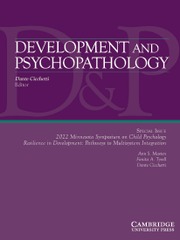Article contents
The role of limbic system irritability in linking history of childhood maltreatment and psychiatric outcomes in low-income, high-risk women: Moderation by FK506 binding protein 5 haplotype
Published online by Cambridge University Press: 15 October 2012
Abstract
Childhood maltreatment is associated with lasting changes in neuroendocrine regulation, alterations in brain structure and function, and symptoms of “limbic irritability.” Limbic irritability symptoms include somatic, sensory, and behavioral phenomena and may stem from increased excitatory neurotransmission following maltreatment. We tested the hypotheses that child maltreatment is indirectly associated with depressive and dissociative symptomatology via indicators of limbic irritability and that variation within the FK506 binding protein 5 gene (FKBP5), a gene involved in glucorticoid receptor functioning, moderates these effects. The sample consisted of high-risk, low-income women (N = 236) living in an inner-city environment. Child maltreatment, limbic irritability, and symptoms of depression and dissociation were measured cross-sectionally using self-report assessments. Haplotype analyses were conducted across four FKBP5 single nucleotide polymorphisms: rs3800373, rs9296158, rs1360870, and rs9470080. Path analysis using bootstrapping procedures was performed to test hypotheses regarding indirect and conditional indirect effects. We found significant indirect effects of maltreatment on depression (β = 0.088, p < .01) and dissociation (β = 0.105, p < .01) via limbic irritability. In addition, variation within FKBP5 moderated these significant indirect effects. For individuals with one to two copies of the CATT haplotype, the indirect effects of maltreatment on depression (β = 0.137, p < .01) and dissociation (β = 0.132, p < .01) via limbic irritability were significant, whereas the indirect paths were not significant for individuals with no copies of this haplotype (depression: β = 0.037, p > .05; dissociation: β = 0.002, p > .05). These results add to the growing evidence that child maltreatment may lead to symptoms of internalizing psychopathology through its impact on the limbic system. In addition, this study revealed a potential role of FKBP5 gene variants in contributing to risk for limbic system dysfunction.
- Type
- Articles
- Information
- Development and Psychopathology , Volume 24 , Issue 4: Contributions of the Genetic/Genomic Sciences to Developmental Psychopathology , November 2012 , pp. 1237 - 1252
- Copyright
- Copyright © Cambridge University Press 2012
References
- 54
- Cited by


